University of [University Name] Construction Digitalization Report
VerifiedAdded on 2023/01/12
|12
|3467
|41
Report
AI Summary
This report provides a critical examination of the digitalization and technological advancements within the construction industry, focusing on articles that discuss mobile computing, ICT, and BIM. The report explores the integration of digital technologies like blockchain, VR, AR, smart sensors, and AI, and their impact on productivity, cost management, and sustainability. It highlights the importance of ICT investment, the challenges in adopting new technologies, and the benefits of sustainable construction practices. The report discusses the role of various stakeholders, including project managers, engineers, and builders, and the importance of ethical and regulatory considerations. It also covers the building process and the integration of technologies like IoT and sustainable construction methods to create a healthy built environment. The report emphasizes the need for the construction industry to adapt to the digital age to improve efficiency and reduce environmental impact.
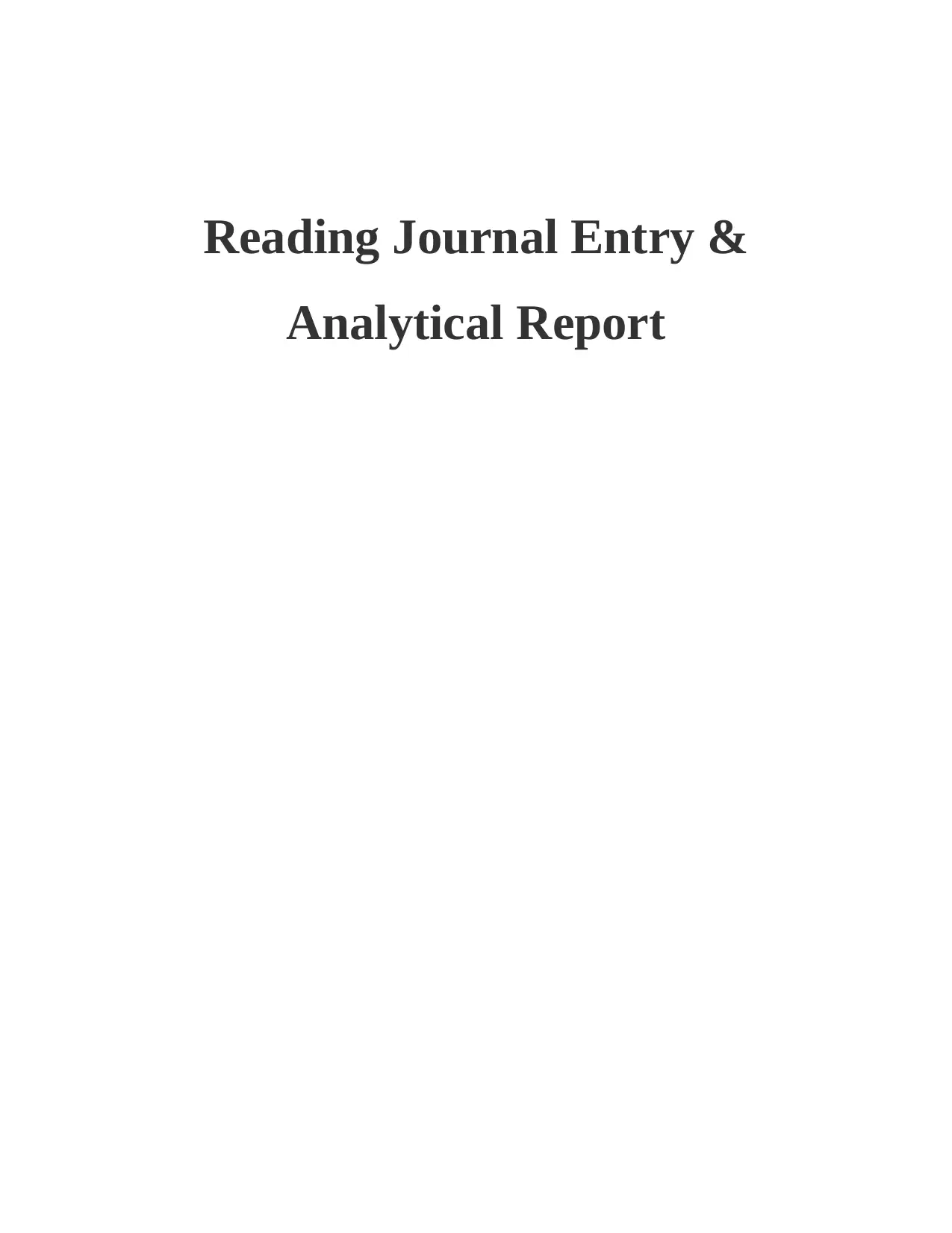
Reading Journal Entry &
Analytical Report
Analytical Report
Paraphrase This Document
Need a fresh take? Get an instant paraphrase of this document with our AI Paraphraser
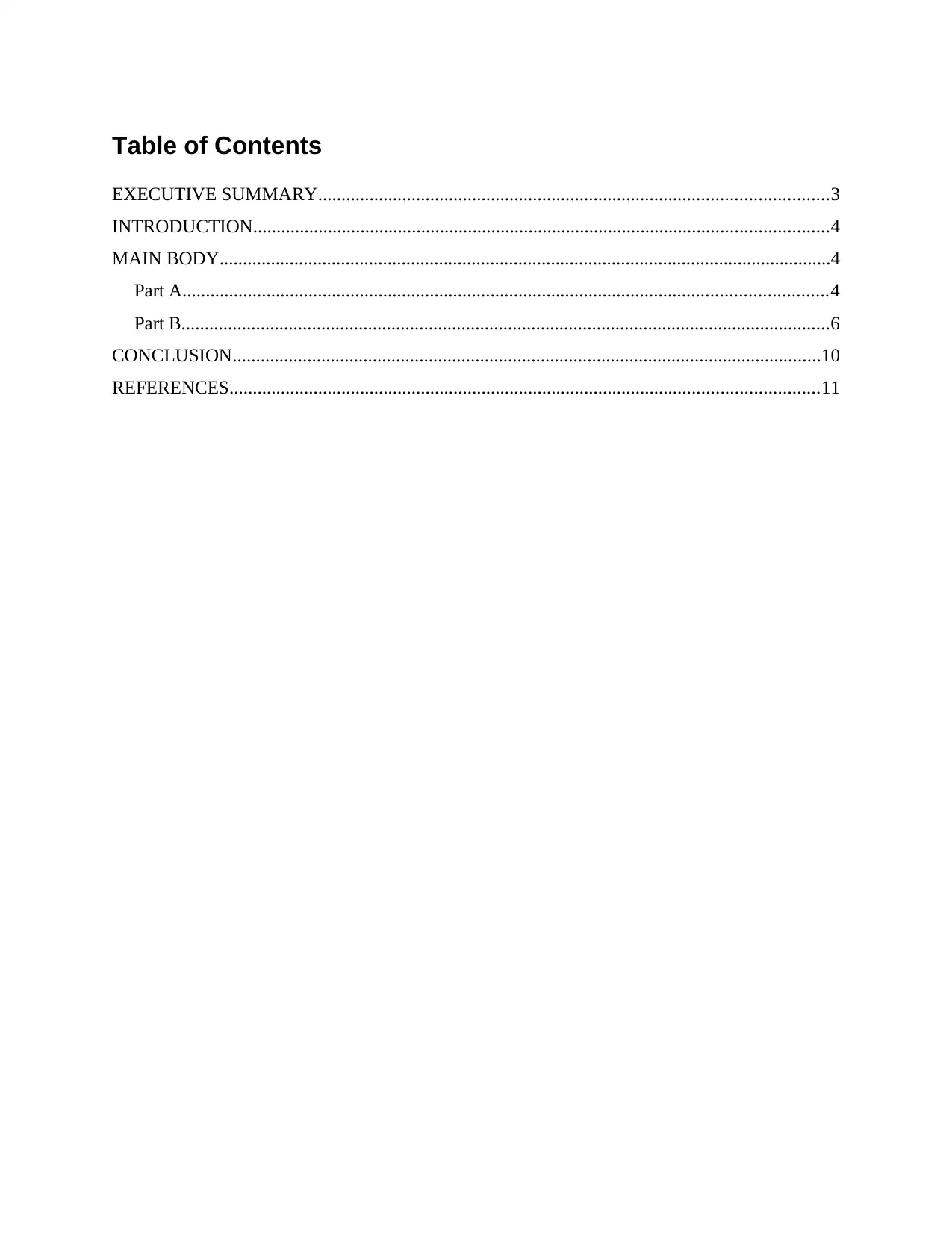
Table of Contents
EXECUTIVE SUMMARY.............................................................................................................3
INTRODUCTION...........................................................................................................................4
MAIN BODY...................................................................................................................................4
Part A..........................................................................................................................................4
Part B...........................................................................................................................................6
CONCLUSION..............................................................................................................................10
REFERENCES..............................................................................................................................11
EXECUTIVE SUMMARY.............................................................................................................3
INTRODUCTION...........................................................................................................................4
MAIN BODY...................................................................................................................................4
Part A..........................................................................................................................................4
Part B...........................................................................................................................................6
CONCLUSION..............................................................................................................................10
REFERENCES..............................................................................................................................11
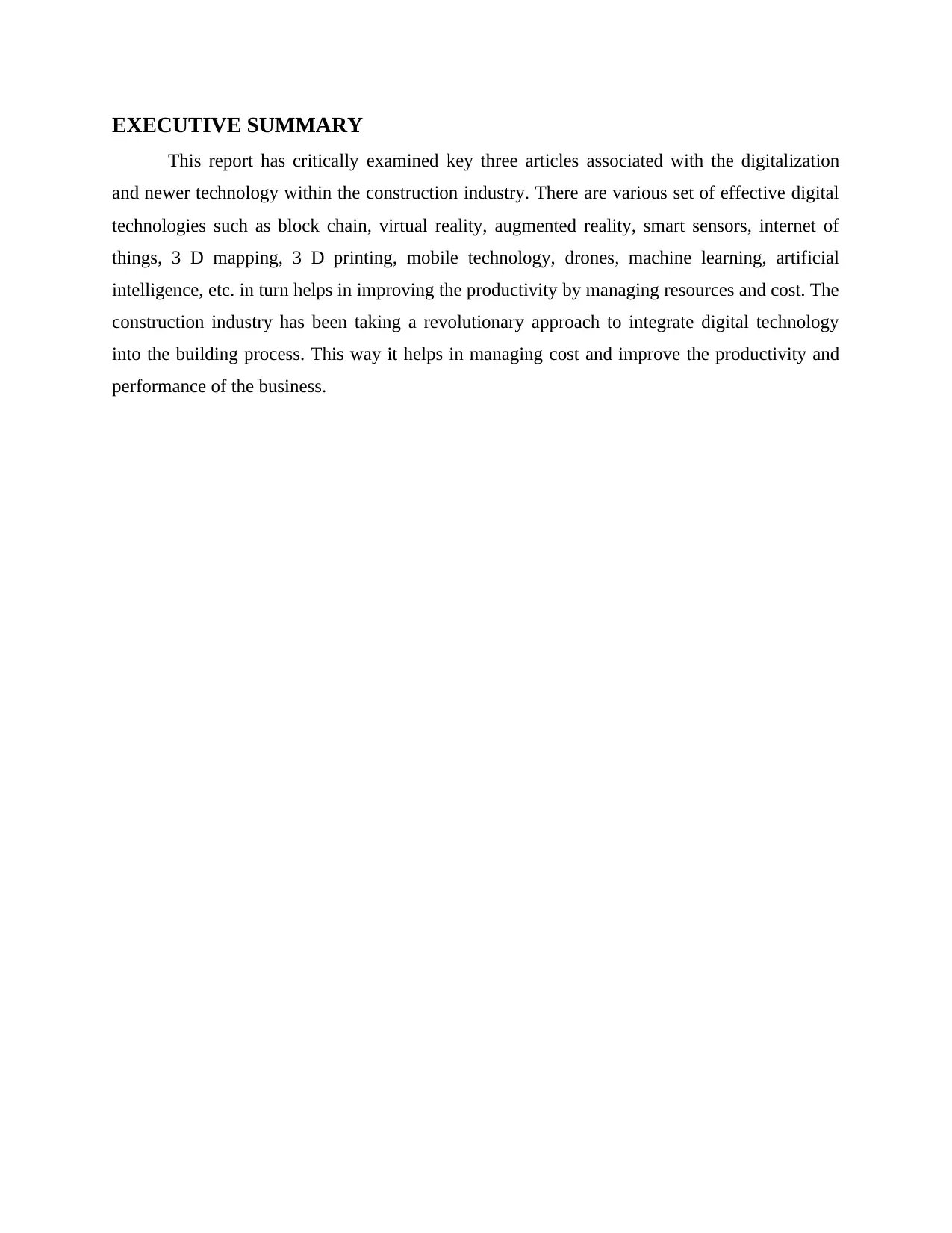
EXECUTIVE SUMMARY
This report has critically examined key three articles associated with the digitalization
and newer technology within the construction industry. There are various set of effective digital
technologies such as block chain, virtual reality, augmented reality, smart sensors, internet of
things, 3 D mapping, 3 D printing, mobile technology, drones, machine learning, artificial
intelligence, etc. in turn helps in improving the productivity by managing resources and cost. The
construction industry has been taking a revolutionary approach to integrate digital technology
into the building process. This way it helps in managing cost and improve the productivity and
performance of the business.
This report has critically examined key three articles associated with the digitalization
and newer technology within the construction industry. There are various set of effective digital
technologies such as block chain, virtual reality, augmented reality, smart sensors, internet of
things, 3 D mapping, 3 D printing, mobile technology, drones, machine learning, artificial
intelligence, etc. in turn helps in improving the productivity by managing resources and cost. The
construction industry has been taking a revolutionary approach to integrate digital technology
into the building process. This way it helps in managing cost and improve the productivity and
performance of the business.
⊘ This is a preview!⊘
Do you want full access?
Subscribe today to unlock all pages.

Trusted by 1+ million students worldwide
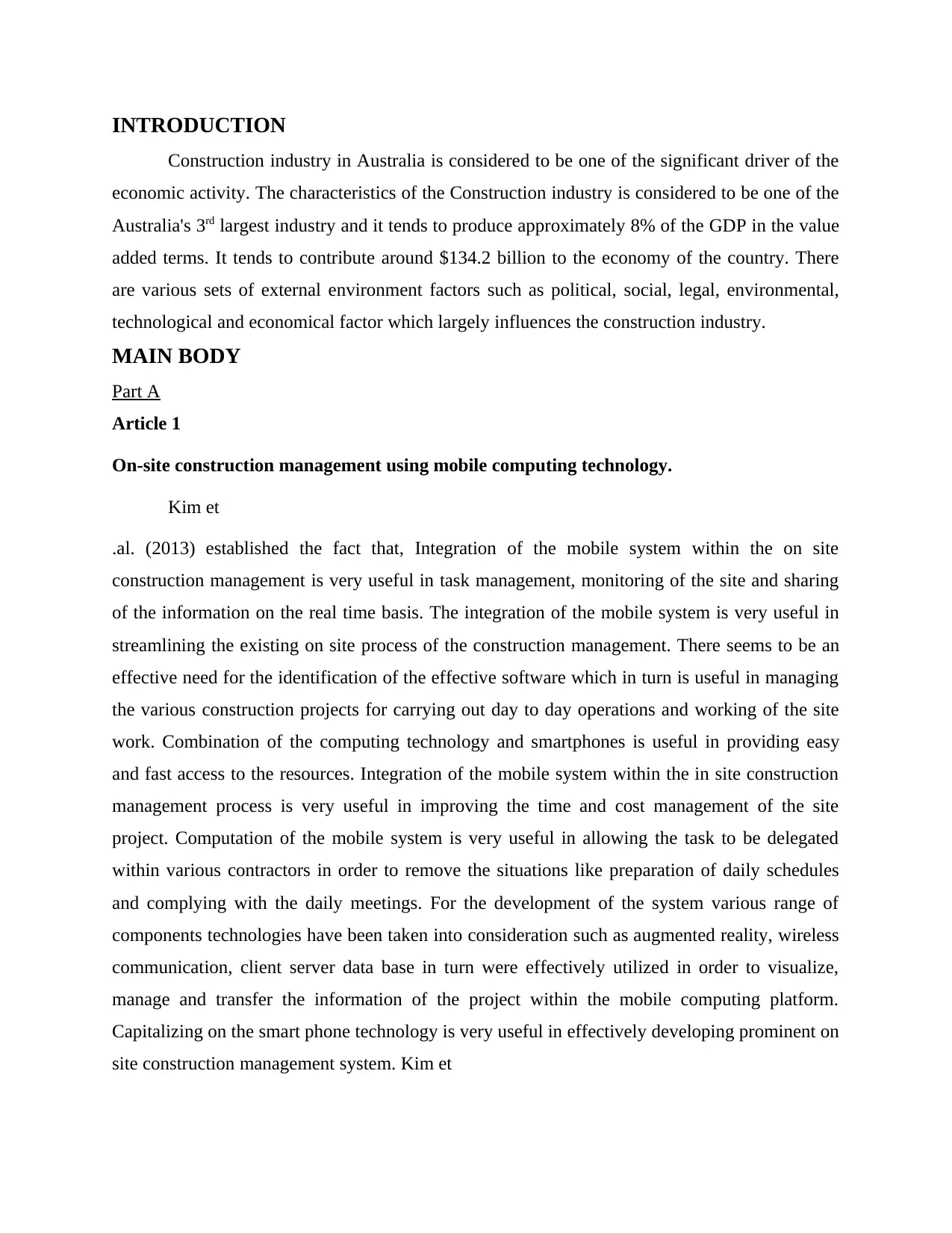
INTRODUCTION
Construction industry in Australia is considered to be one of the significant driver of the
economic activity. The characteristics of the Construction industry is considered to be one of the
Australia's 3rd largest industry and it tends to produce approximately 8% of the GDP in the value
added terms. It tends to contribute around $134.2 billion to the economy of the country. There
are various sets of external environment factors such as political, social, legal, environmental,
technological and economical factor which largely influences the construction industry.
MAIN BODY
Part A
Article 1
On-site construction management using mobile computing technology.
Kim et
.al. (2013) established the fact that, Integration of the mobile system within the on site
construction management is very useful in task management, monitoring of the site and sharing
of the information on the real time basis. The integration of the mobile system is very useful in
streamlining the existing on site process of the construction management. There seems to be an
effective need for the identification of the effective software which in turn is useful in managing
the various construction projects for carrying out day to day operations and working of the site
work. Combination of the computing technology and smartphones is useful in providing easy
and fast access to the resources. Integration of the mobile system within the in site construction
management process is very useful in improving the time and cost management of the site
project. Computation of the mobile system is very useful in allowing the task to be delegated
within various contractors in order to remove the situations like preparation of daily schedules
and complying with the daily meetings. For the development of the system various range of
components technologies have been taken into consideration such as augmented reality, wireless
communication, client server data base in turn were effectively utilized in order to visualize,
manage and transfer the information of the project within the mobile computing platform.
Capitalizing on the smart phone technology is very useful in effectively developing prominent on
site construction management system. Kim et
Construction industry in Australia is considered to be one of the significant driver of the
economic activity. The characteristics of the Construction industry is considered to be one of the
Australia's 3rd largest industry and it tends to produce approximately 8% of the GDP in the value
added terms. It tends to contribute around $134.2 billion to the economy of the country. There
are various sets of external environment factors such as political, social, legal, environmental,
technological and economical factor which largely influences the construction industry.
MAIN BODY
Part A
Article 1
On-site construction management using mobile computing technology.
Kim et
.al. (2013) established the fact that, Integration of the mobile system within the on site
construction management is very useful in task management, monitoring of the site and sharing
of the information on the real time basis. The integration of the mobile system is very useful in
streamlining the existing on site process of the construction management. There seems to be an
effective need for the identification of the effective software which in turn is useful in managing
the various construction projects for carrying out day to day operations and working of the site
work. Combination of the computing technology and smartphones is useful in providing easy
and fast access to the resources. Integration of the mobile system within the in site construction
management process is very useful in improving the time and cost management of the site
project. Computation of the mobile system is very useful in allowing the task to be delegated
within various contractors in order to remove the situations like preparation of daily schedules
and complying with the daily meetings. For the development of the system various range of
components technologies have been taken into consideration such as augmented reality, wireless
communication, client server data base in turn were effectively utilized in order to visualize,
manage and transfer the information of the project within the mobile computing platform.
Capitalizing on the smart phone technology is very useful in effectively developing prominent on
site construction management system. Kim et
Paraphrase This Document
Need a fresh take? Get an instant paraphrase of this document with our AI Paraphraser
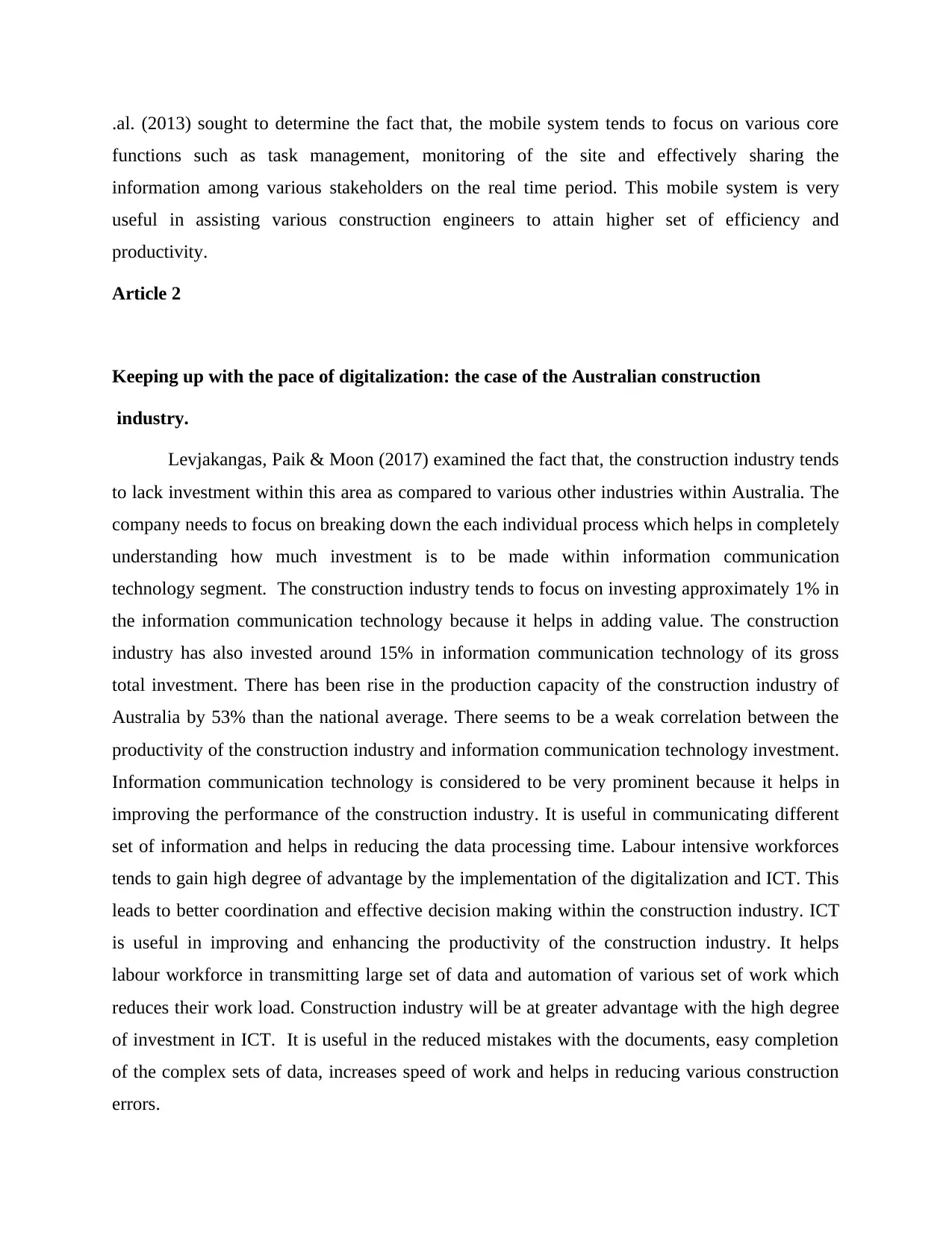
.al. (2013) sought to determine the fact that, the mobile system tends to focus on various core
functions such as task management, monitoring of the site and effectively sharing the
information among various stakeholders on the real time period. This mobile system is very
useful in assisting various construction engineers to attain higher set of efficiency and
productivity.
Article 2
Keeping up with the pace of digitalization: the case of the Australian construction
industry.
Levjakangas, Paik & Moon (2017) examined the fact that, the construction industry tends
to lack investment within this area as compared to various other industries within Australia. The
company needs to focus on breaking down the each individual process which helps in completely
understanding how much investment is to be made within information communication
technology segment. The construction industry tends to focus on investing approximately 1% in
the information communication technology because it helps in adding value. The construction
industry has also invested around 15% in information communication technology of its gross
total investment. There has been rise in the production capacity of the construction industry of
Australia by 53% than the national average. There seems to be a weak correlation between the
productivity of the construction industry and information communication technology investment.
Information communication technology is considered to be very prominent because it helps in
improving the performance of the construction industry. It is useful in communicating different
set of information and helps in reducing the data processing time. Labour intensive workforces
tends to gain high degree of advantage by the implementation of the digitalization and ICT. This
leads to better coordination and effective decision making within the construction industry. ICT
is useful in improving and enhancing the productivity of the construction industry. It helps
labour workforce in transmitting large set of data and automation of various set of work which
reduces their work load. Construction industry will be at greater advantage with the high degree
of investment in ICT. It is useful in the reduced mistakes with the documents, easy completion
of the complex sets of data, increases speed of work and helps in reducing various construction
errors.
functions such as task management, monitoring of the site and effectively sharing the
information among various stakeholders on the real time period. This mobile system is very
useful in assisting various construction engineers to attain higher set of efficiency and
productivity.
Article 2
Keeping up with the pace of digitalization: the case of the Australian construction
industry.
Levjakangas, Paik & Moon (2017) examined the fact that, the construction industry tends
to lack investment within this area as compared to various other industries within Australia. The
company needs to focus on breaking down the each individual process which helps in completely
understanding how much investment is to be made within information communication
technology segment. The construction industry tends to focus on investing approximately 1% in
the information communication technology because it helps in adding value. The construction
industry has also invested around 15% in information communication technology of its gross
total investment. There has been rise in the production capacity of the construction industry of
Australia by 53% than the national average. There seems to be a weak correlation between the
productivity of the construction industry and information communication technology investment.
Information communication technology is considered to be very prominent because it helps in
improving the performance of the construction industry. It is useful in communicating different
set of information and helps in reducing the data processing time. Labour intensive workforces
tends to gain high degree of advantage by the implementation of the digitalization and ICT. This
leads to better coordination and effective decision making within the construction industry. ICT
is useful in improving and enhancing the productivity of the construction industry. It helps
labour workforce in transmitting large set of data and automation of various set of work which
reduces their work load. Construction industry will be at greater advantage with the high degree
of investment in ICT. It is useful in the reduced mistakes with the documents, easy completion
of the complex sets of data, increases speed of work and helps in reducing various construction
errors.
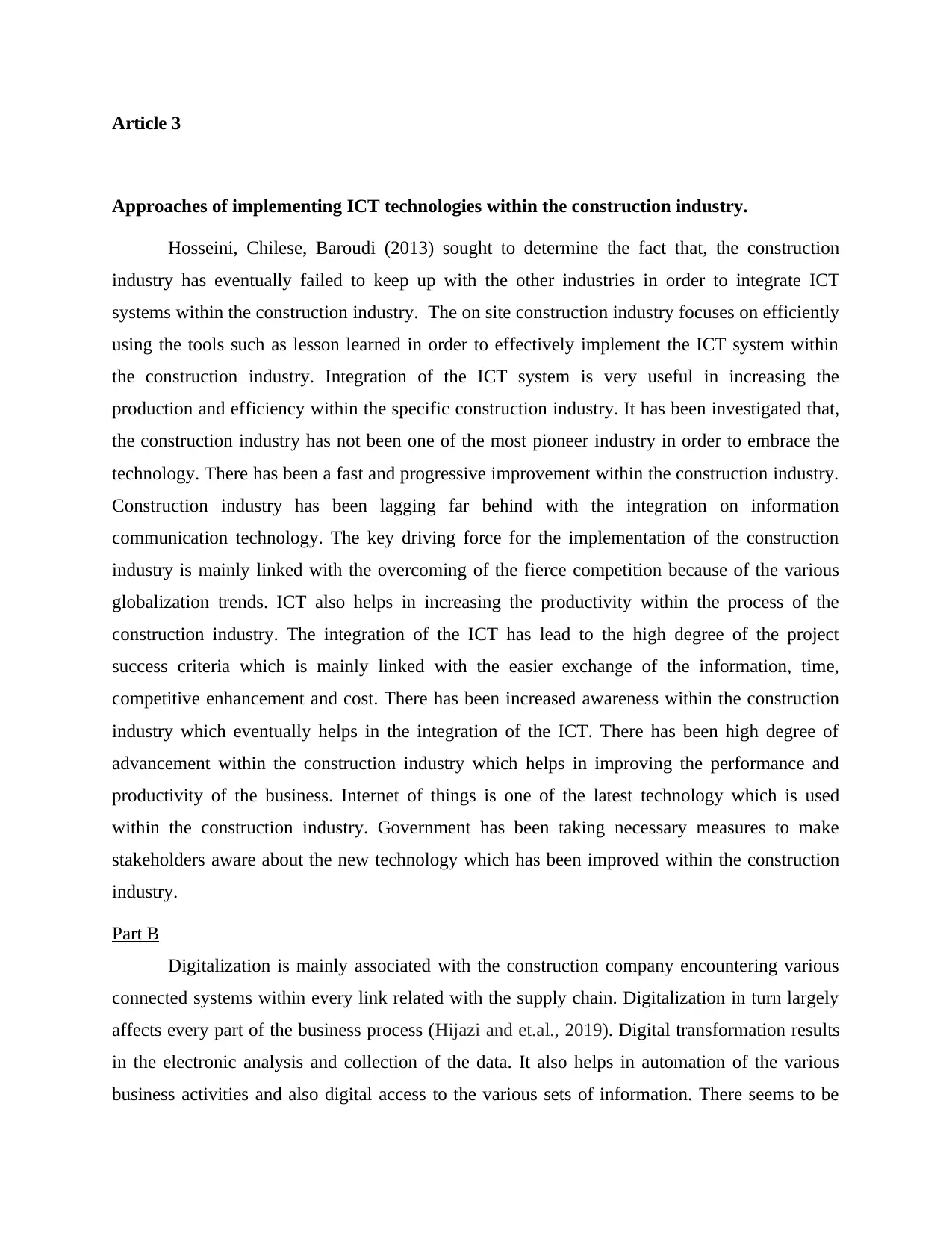
Article 3
Approaches of implementing ICT technologies within the construction industry.
Hosseini, Chilese, Baroudi (2013) sought to determine the fact that, the construction
industry has eventually failed to keep up with the other industries in order to integrate ICT
systems within the construction industry. The on site construction industry focuses on efficiently
using the tools such as lesson learned in order to effectively implement the ICT system within
the construction industry. Integration of the ICT system is very useful in increasing the
production and efficiency within the specific construction industry. It has been investigated that,
the construction industry has not been one of the most pioneer industry in order to embrace the
technology. There has been a fast and progressive improvement within the construction industry.
Construction industry has been lagging far behind with the integration on information
communication technology. The key driving force for the implementation of the construction
industry is mainly linked with the overcoming of the fierce competition because of the various
globalization trends. ICT also helps in increasing the productivity within the process of the
construction industry. The integration of the ICT has lead to the high degree of the project
success criteria which is mainly linked with the easier exchange of the information, time,
competitive enhancement and cost. There has been increased awareness within the construction
industry which eventually helps in the integration of the ICT. There has been high degree of
advancement within the construction industry which helps in improving the performance and
productivity of the business. Internet of things is one of the latest technology which is used
within the construction industry. Government has been taking necessary measures to make
stakeholders aware about the new technology which has been improved within the construction
industry.
Part B
Digitalization is mainly associated with the construction company encountering various
connected systems within every link related with the supply chain. Digitalization in turn largely
affects every part of the business process (Hijazi and et.al., 2019). Digital transformation results
in the electronic analysis and collection of the data. It also helps in automation of the various
business activities and also digital access to the various sets of information. There seems to be
Approaches of implementing ICT technologies within the construction industry.
Hosseini, Chilese, Baroudi (2013) sought to determine the fact that, the construction
industry has eventually failed to keep up with the other industries in order to integrate ICT
systems within the construction industry. The on site construction industry focuses on efficiently
using the tools such as lesson learned in order to effectively implement the ICT system within
the construction industry. Integration of the ICT system is very useful in increasing the
production and efficiency within the specific construction industry. It has been investigated that,
the construction industry has not been one of the most pioneer industry in order to embrace the
technology. There has been a fast and progressive improvement within the construction industry.
Construction industry has been lagging far behind with the integration on information
communication technology. The key driving force for the implementation of the construction
industry is mainly linked with the overcoming of the fierce competition because of the various
globalization trends. ICT also helps in increasing the productivity within the process of the
construction industry. The integration of the ICT has lead to the high degree of the project
success criteria which is mainly linked with the easier exchange of the information, time,
competitive enhancement and cost. There has been increased awareness within the construction
industry which eventually helps in the integration of the ICT. There has been high degree of
advancement within the construction industry which helps in improving the performance and
productivity of the business. Internet of things is one of the latest technology which is used
within the construction industry. Government has been taking necessary measures to make
stakeholders aware about the new technology which has been improved within the construction
industry.
Part B
Digitalization is mainly associated with the construction company encountering various
connected systems within every link related with the supply chain. Digitalization in turn largely
affects every part of the business process (Hijazi and et.al., 2019). Digital transformation results
in the electronic analysis and collection of the data. It also helps in automation of the various
business activities and also digital access to the various sets of information. There seems to be
⊘ This is a preview!⊘
Do you want full access?
Subscribe today to unlock all pages.

Trusted by 1+ million students worldwide
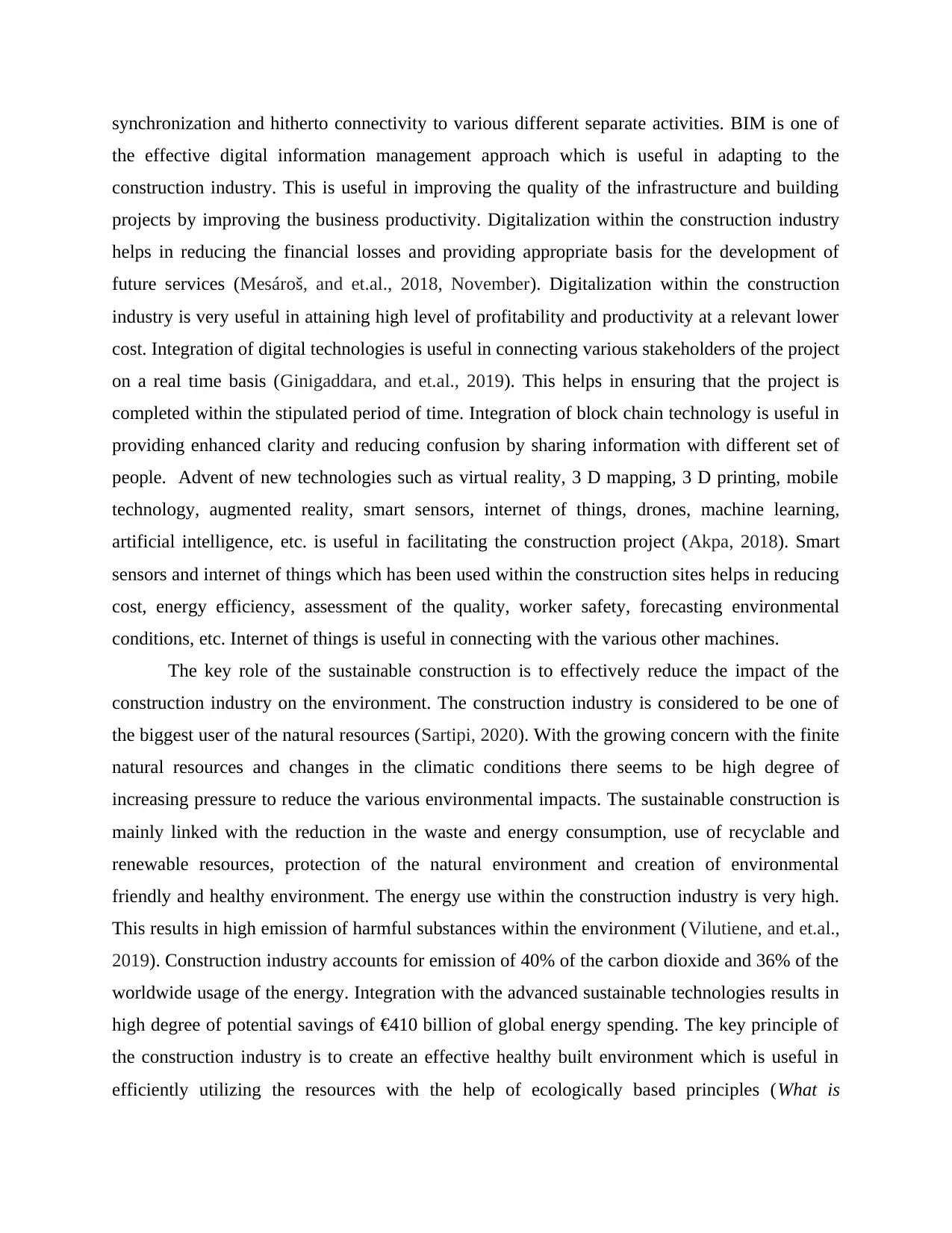
synchronization and hitherto connectivity to various different separate activities. BIM is one of
the effective digital information management approach which is useful in adapting to the
construction industry. This is useful in improving the quality of the infrastructure and building
projects by improving the business productivity. Digitalization within the construction industry
helps in reducing the financial losses and providing appropriate basis for the development of
future services (Mesároš, and et.al., 2018, November). Digitalization within the construction
industry is very useful in attaining high level of profitability and productivity at a relevant lower
cost. Integration of digital technologies is useful in connecting various stakeholders of the project
on a real time basis (Ginigaddara, and et.al., 2019). This helps in ensuring that the project is
completed within the stipulated period of time. Integration of block chain technology is useful in
providing enhanced clarity and reducing confusion by sharing information with different set of
people. Advent of new technologies such as virtual reality, 3 D mapping, 3 D printing, mobile
technology, augmented reality, smart sensors, internet of things, drones, machine learning,
artificial intelligence, etc. is useful in facilitating the construction project (Akpa, 2018). Smart
sensors and internet of things which has been used within the construction sites helps in reducing
cost, energy efficiency, assessment of the quality, worker safety, forecasting environmental
conditions, etc. Internet of things is useful in connecting with the various other machines.
The key role of the sustainable construction is to effectively reduce the impact of the
construction industry on the environment. The construction industry is considered to be one of
the biggest user of the natural resources (Sartipi, 2020). With the growing concern with the finite
natural resources and changes in the climatic conditions there seems to be high degree of
increasing pressure to reduce the various environmental impacts. The sustainable construction is
mainly linked with the reduction in the waste and energy consumption, use of recyclable and
renewable resources, protection of the natural environment and creation of environmental
friendly and healthy environment. The energy use within the construction industry is very high.
This results in high emission of harmful substances within the environment (Vilutiene, and et.al.,
2019). Construction industry accounts for emission of 40% of the carbon dioxide and 36% of the
worldwide usage of the energy. Integration with the advanced sustainable technologies results in
high degree of potential savings of €410 billion of global energy spending. The key principle of
the construction industry is to create an effective healthy built environment which is useful in
efficiently utilizing the resources with the help of ecologically based principles (What is
the effective digital information management approach which is useful in adapting to the
construction industry. This is useful in improving the quality of the infrastructure and building
projects by improving the business productivity. Digitalization within the construction industry
helps in reducing the financial losses and providing appropriate basis for the development of
future services (Mesároš, and et.al., 2018, November). Digitalization within the construction
industry is very useful in attaining high level of profitability and productivity at a relevant lower
cost. Integration of digital technologies is useful in connecting various stakeholders of the project
on a real time basis (Ginigaddara, and et.al., 2019). This helps in ensuring that the project is
completed within the stipulated period of time. Integration of block chain technology is useful in
providing enhanced clarity and reducing confusion by sharing information with different set of
people. Advent of new technologies such as virtual reality, 3 D mapping, 3 D printing, mobile
technology, augmented reality, smart sensors, internet of things, drones, machine learning,
artificial intelligence, etc. is useful in facilitating the construction project (Akpa, 2018). Smart
sensors and internet of things which has been used within the construction sites helps in reducing
cost, energy efficiency, assessment of the quality, worker safety, forecasting environmental
conditions, etc. Internet of things is useful in connecting with the various other machines.
The key role of the sustainable construction is to effectively reduce the impact of the
construction industry on the environment. The construction industry is considered to be one of
the biggest user of the natural resources (Sartipi, 2020). With the growing concern with the finite
natural resources and changes in the climatic conditions there seems to be high degree of
increasing pressure to reduce the various environmental impacts. The sustainable construction is
mainly linked with the reduction in the waste and energy consumption, use of recyclable and
renewable resources, protection of the natural environment and creation of environmental
friendly and healthy environment. The energy use within the construction industry is very high.
This results in high emission of harmful substances within the environment (Vilutiene, and et.al.,
2019). Construction industry accounts for emission of 40% of the carbon dioxide and 36% of the
worldwide usage of the energy. Integration with the advanced sustainable technologies results in
high degree of potential savings of €410 billion of global energy spending. The key principle of
the construction industry is to create an effective healthy built environment which is useful in
efficiently utilizing the resources with the help of ecologically based principles (What is
Paraphrase This Document
Need a fresh take? Get an instant paraphrase of this document with our AI Paraphraser
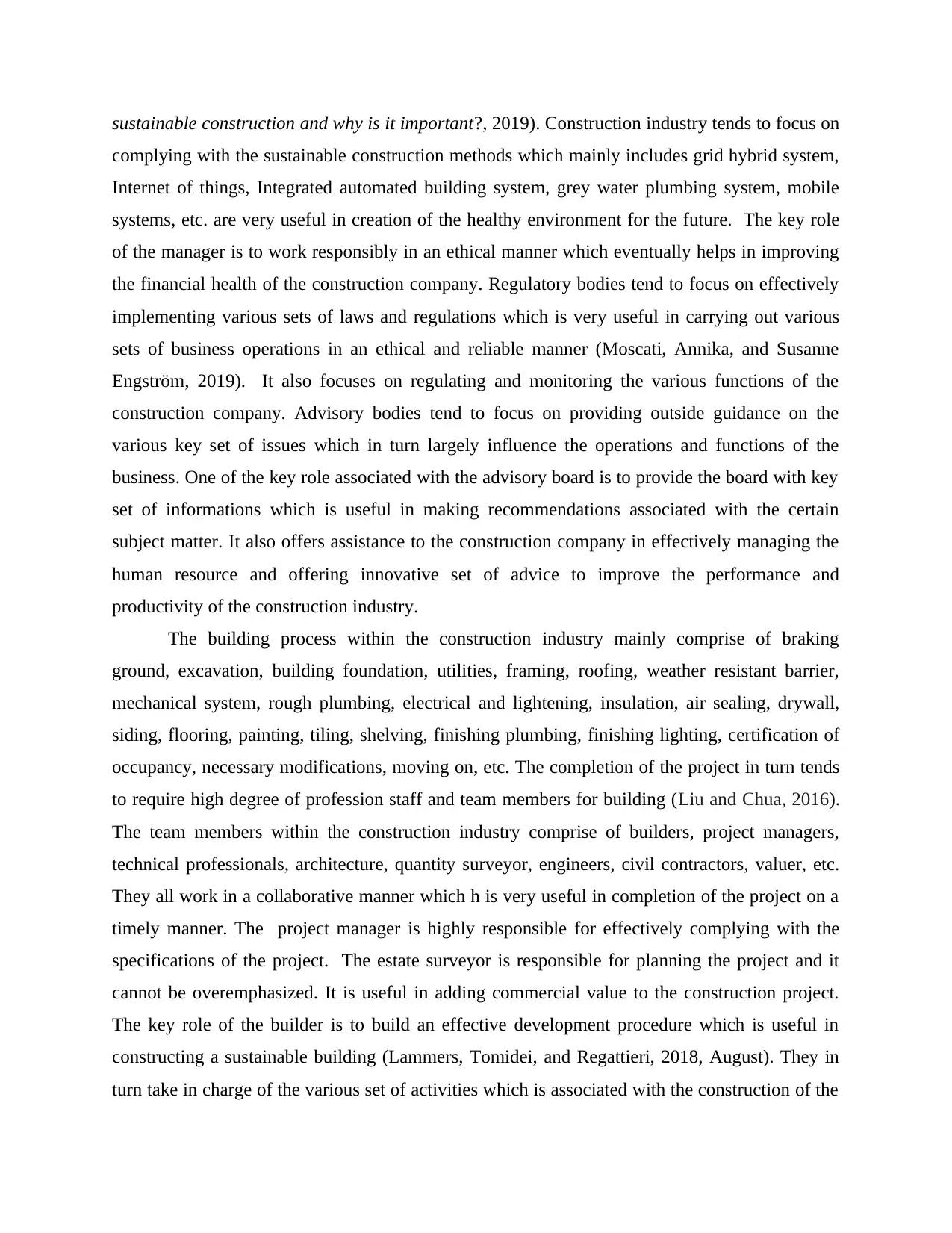
sustainable construction and why is it important?, 2019). Construction industry tends to focus on
complying with the sustainable construction methods which mainly includes grid hybrid system,
Internet of things, Integrated automated building system, grey water plumbing system, mobile
systems, etc. are very useful in creation of the healthy environment for the future. The key role
of the manager is to work responsibly in an ethical manner which eventually helps in improving
the financial health of the construction company. Regulatory bodies tend to focus on effectively
implementing various sets of laws and regulations which is very useful in carrying out various
sets of business operations in an ethical and reliable manner (Moscati, Annika, and Susanne
Engström, 2019). It also focuses on regulating and monitoring the various functions of the
construction company. Advisory bodies tend to focus on providing outside guidance on the
various key set of issues which in turn largely influence the operations and functions of the
business. One of the key role associated with the advisory board is to provide the board with key
set of informations which is useful in making recommendations associated with the certain
subject matter. It also offers assistance to the construction company in effectively managing the
human resource and offering innovative set of advice to improve the performance and
productivity of the construction industry.
The building process within the construction industry mainly comprise of braking
ground, excavation, building foundation, utilities, framing, roofing, weather resistant barrier,
mechanical system, rough plumbing, electrical and lightening, insulation, air sealing, drywall,
siding, flooring, painting, tiling, shelving, finishing plumbing, finishing lighting, certification of
occupancy, necessary modifications, moving on, etc. The completion of the project in turn tends
to require high degree of profession staff and team members for building (Liu and Chua, 2016).
The team members within the construction industry comprise of builders, project managers,
technical professionals, architecture, quantity surveyor, engineers, civil contractors, valuer, etc.
They all work in a collaborative manner which h is very useful in completion of the project on a
timely manner. The project manager is highly responsible for effectively complying with the
specifications of the project. The estate surveyor is responsible for planning the project and it
cannot be overemphasized. It is useful in adding commercial value to the construction project.
The key role of the builder is to build an effective development procedure which is useful in
constructing a sustainable building (Lammers, Tomidei, and Regattieri, 2018, August). They in
turn take in charge of the various set of activities which is associated with the construction of the
complying with the sustainable construction methods which mainly includes grid hybrid system,
Internet of things, Integrated automated building system, grey water plumbing system, mobile
systems, etc. are very useful in creation of the healthy environment for the future. The key role
of the manager is to work responsibly in an ethical manner which eventually helps in improving
the financial health of the construction company. Regulatory bodies tend to focus on effectively
implementing various sets of laws and regulations which is very useful in carrying out various
sets of business operations in an ethical and reliable manner (Moscati, Annika, and Susanne
Engström, 2019). It also focuses on regulating and monitoring the various functions of the
construction company. Advisory bodies tend to focus on providing outside guidance on the
various key set of issues which in turn largely influence the operations and functions of the
business. One of the key role associated with the advisory board is to provide the board with key
set of informations which is useful in making recommendations associated with the certain
subject matter. It also offers assistance to the construction company in effectively managing the
human resource and offering innovative set of advice to improve the performance and
productivity of the construction industry.
The building process within the construction industry mainly comprise of braking
ground, excavation, building foundation, utilities, framing, roofing, weather resistant barrier,
mechanical system, rough plumbing, electrical and lightening, insulation, air sealing, drywall,
siding, flooring, painting, tiling, shelving, finishing plumbing, finishing lighting, certification of
occupancy, necessary modifications, moving on, etc. The completion of the project in turn tends
to require high degree of profession staff and team members for building (Liu and Chua, 2016).
The team members within the construction industry comprise of builders, project managers,
technical professionals, architecture, quantity surveyor, engineers, civil contractors, valuer, etc.
They all work in a collaborative manner which h is very useful in completion of the project on a
timely manner. The project manager is highly responsible for effectively complying with the
specifications of the project. The estate surveyor is responsible for planning the project and it
cannot be overemphasized. It is useful in adding commercial value to the construction project.
The key role of the builder is to build an effective development procedure which is useful in
constructing a sustainable building (Lammers, Tomidei, and Regattieri, 2018, August). They in
turn take in charge of the various set of activities which is associated with the construction of the
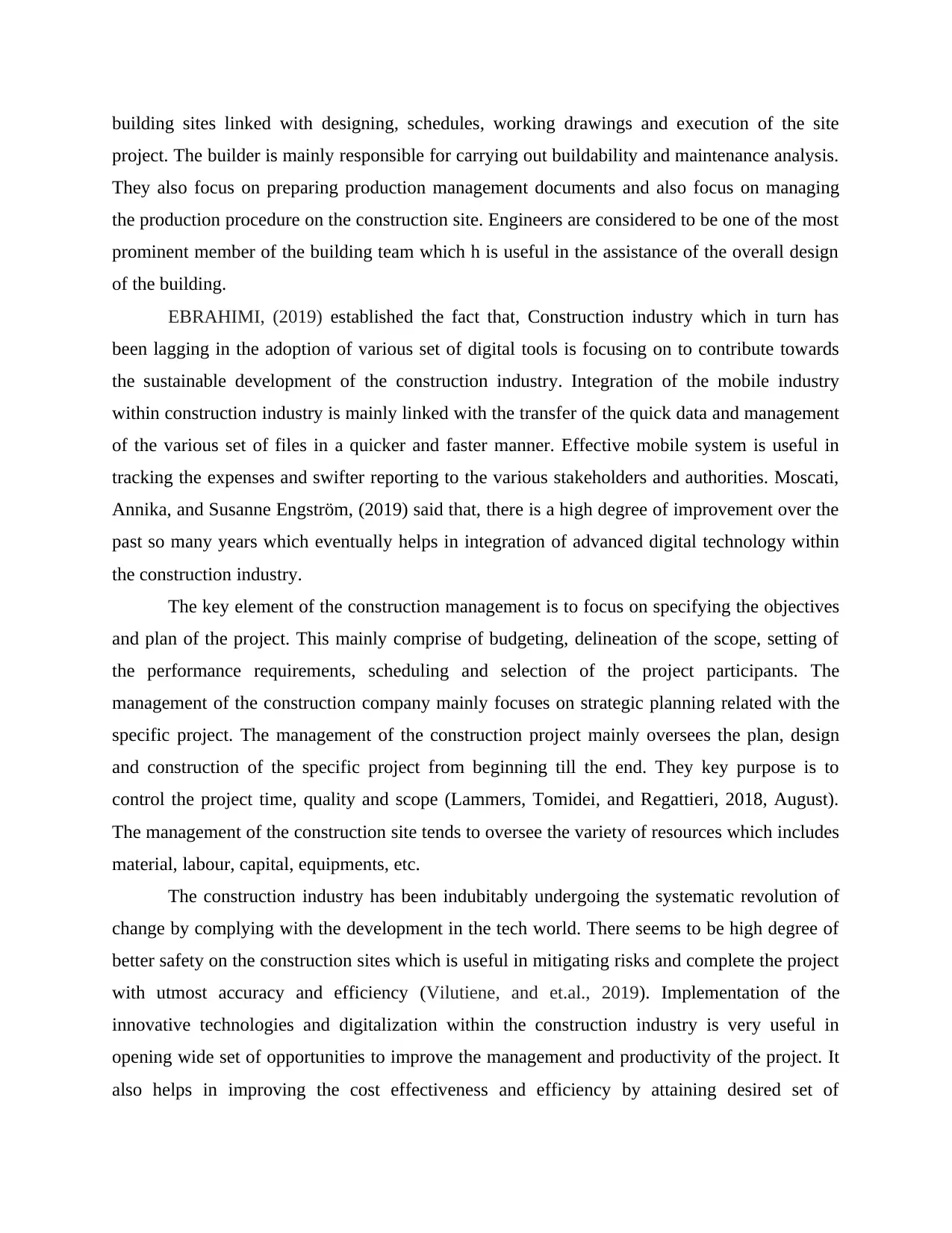
building sites linked with designing, schedules, working drawings and execution of the site
project. The builder is mainly responsible for carrying out buildability and maintenance analysis.
They also focus on preparing production management documents and also focus on managing
the production procedure on the construction site. Engineers are considered to be one of the most
prominent member of the building team which h is useful in the assistance of the overall design
of the building.
EBRAHIMI, (2019) established the fact that, Construction industry which in turn has
been lagging in the adoption of various set of digital tools is focusing on to contribute towards
the sustainable development of the construction industry. Integration of the mobile industry
within construction industry is mainly linked with the transfer of the quick data and management
of the various set of files in a quicker and faster manner. Effective mobile system is useful in
tracking the expenses and swifter reporting to the various stakeholders and authorities. Moscati,
Annika, and Susanne Engström, (2019) said that, there is a high degree of improvement over the
past so many years which eventually helps in integration of advanced digital technology within
the construction industry.
The key element of the construction management is to focus on specifying the objectives
and plan of the project. This mainly comprise of budgeting, delineation of the scope, setting of
the performance requirements, scheduling and selection of the project participants. The
management of the construction company mainly focuses on strategic planning related with the
specific project. The management of the construction project mainly oversees the plan, design
and construction of the specific project from beginning till the end. They key purpose is to
control the project time, quality and scope (Lammers, Tomidei, and Regattieri, 2018, August).
The management of the construction site tends to oversee the variety of resources which includes
material, labour, capital, equipments, etc.
The construction industry has been indubitably undergoing the systematic revolution of
change by complying with the development in the tech world. There seems to be high degree of
better safety on the construction sites which is useful in mitigating risks and complete the project
with utmost accuracy and efficiency (Vilutiene, and et.al., 2019). Implementation of the
innovative technologies and digitalization within the construction industry is very useful in
opening wide set of opportunities to improve the management and productivity of the project. It
also helps in improving the cost effectiveness and efficiency by attaining desired set of
project. The builder is mainly responsible for carrying out buildability and maintenance analysis.
They also focus on preparing production management documents and also focus on managing
the production procedure on the construction site. Engineers are considered to be one of the most
prominent member of the building team which h is useful in the assistance of the overall design
of the building.
EBRAHIMI, (2019) established the fact that, Construction industry which in turn has
been lagging in the adoption of various set of digital tools is focusing on to contribute towards
the sustainable development of the construction industry. Integration of the mobile industry
within construction industry is mainly linked with the transfer of the quick data and management
of the various set of files in a quicker and faster manner. Effective mobile system is useful in
tracking the expenses and swifter reporting to the various stakeholders and authorities. Moscati,
Annika, and Susanne Engström, (2019) said that, there is a high degree of improvement over the
past so many years which eventually helps in integration of advanced digital technology within
the construction industry.
The key element of the construction management is to focus on specifying the objectives
and plan of the project. This mainly comprise of budgeting, delineation of the scope, setting of
the performance requirements, scheduling and selection of the project participants. The
management of the construction company mainly focuses on strategic planning related with the
specific project. The management of the construction project mainly oversees the plan, design
and construction of the specific project from beginning till the end. They key purpose is to
control the project time, quality and scope (Lammers, Tomidei, and Regattieri, 2018, August).
The management of the construction site tends to oversee the variety of resources which includes
material, labour, capital, equipments, etc.
The construction industry has been indubitably undergoing the systematic revolution of
change by complying with the development in the tech world. There seems to be high degree of
better safety on the construction sites which is useful in mitigating risks and complete the project
with utmost accuracy and efficiency (Vilutiene, and et.al., 2019). Implementation of the
innovative technologies and digitalization within the construction industry is very useful in
opening wide set of opportunities to improve the management and productivity of the project. It
also helps in improving the cost effectiveness and efficiency by attaining desired set of
⊘ This is a preview!⊘
Do you want full access?
Subscribe today to unlock all pages.

Trusted by 1+ million students worldwide
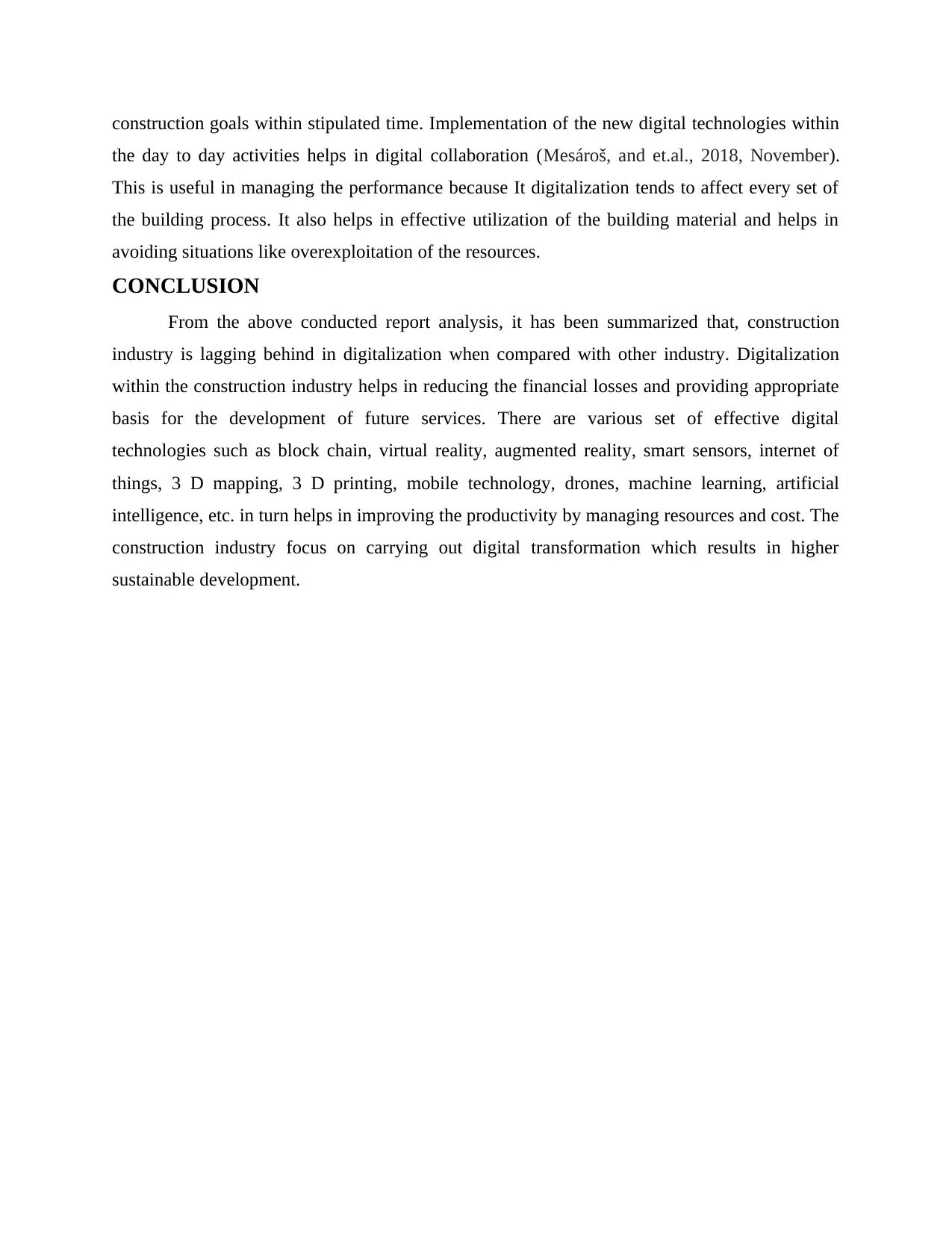
construction goals within stipulated time. Implementation of the new digital technologies within
the day to day activities helps in digital collaboration (Mesároš, and et.al., 2018, November).
This is useful in managing the performance because It digitalization tends to affect every set of
the building process. It also helps in effective utilization of the building material and helps in
avoiding situations like overexploitation of the resources.
CONCLUSION
From the above conducted report analysis, it has been summarized that, construction
industry is lagging behind in digitalization when compared with other industry. Digitalization
within the construction industry helps in reducing the financial losses and providing appropriate
basis for the development of future services. There are various set of effective digital
technologies such as block chain, virtual reality, augmented reality, smart sensors, internet of
things, 3 D mapping, 3 D printing, mobile technology, drones, machine learning, artificial
intelligence, etc. in turn helps in improving the productivity by managing resources and cost. The
construction industry focus on carrying out digital transformation which results in higher
sustainable development.
the day to day activities helps in digital collaboration (Mesároš, and et.al., 2018, November).
This is useful in managing the performance because It digitalization tends to affect every set of
the building process. It also helps in effective utilization of the building material and helps in
avoiding situations like overexploitation of the resources.
CONCLUSION
From the above conducted report analysis, it has been summarized that, construction
industry is lagging behind in digitalization when compared with other industry. Digitalization
within the construction industry helps in reducing the financial losses and providing appropriate
basis for the development of future services. There are various set of effective digital
technologies such as block chain, virtual reality, augmented reality, smart sensors, internet of
things, 3 D mapping, 3 D printing, mobile technology, drones, machine learning, artificial
intelligence, etc. in turn helps in improving the productivity by managing resources and cost. The
construction industry focus on carrying out digital transformation which results in higher
sustainable development.
Paraphrase This Document
Need a fresh take? Get an instant paraphrase of this document with our AI Paraphraser
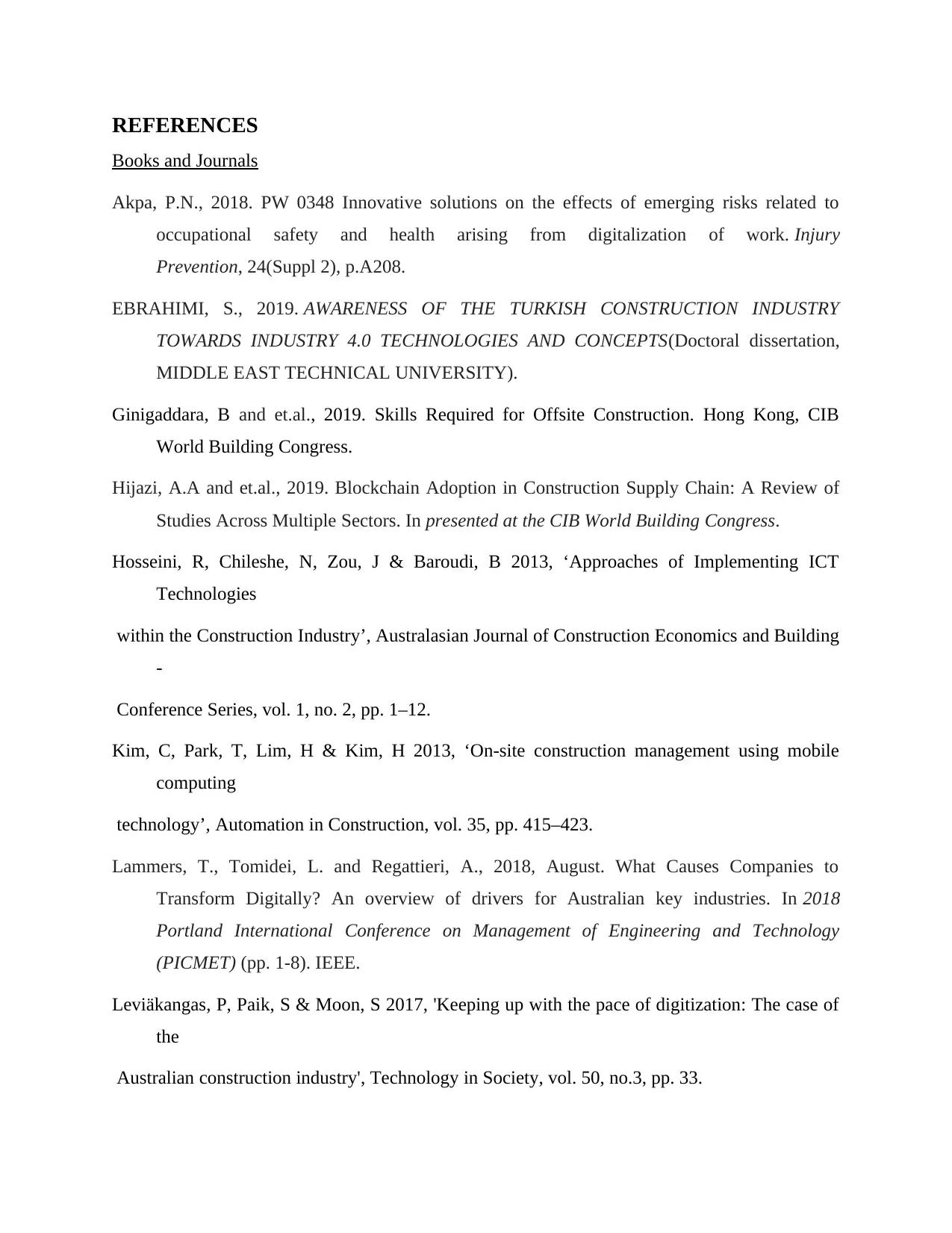
REFERENCES
Books and Journals
Akpa, P.N., 2018. PW 0348 Innovative solutions on the effects of emerging risks related to
occupational safety and health arising from digitalization of work. Injury
Prevention, 24(Suppl 2), p.A208.
EBRAHIMI, S., 2019. AWARENESS OF THE TURKISH CONSTRUCTION INDUSTRY
TOWARDS INDUSTRY 4.0 TECHNOLOGIES AND CONCEPTS(Doctoral dissertation,
MIDDLE EAST TECHNICAL UNIVERSITY).
Ginigaddara, B and et.al., 2019. Skills Required for Offsite Construction. Hong Kong, CIB
World Building Congress.
Hijazi, A.A and et.al., 2019. Blockchain Adoption in Construction Supply Chain: A Review of
Studies Across Multiple Sectors. In presented at the CIB World Building Congress.
Hosseini, R, Chileshe, N, Zou, J & Baroudi, B 2013, ‘Approaches of Implementing ICT
Technologies
within the Construction Industry’, Australasian Journal of Construction Economics and Building
-
Conference Series, vol. 1, no. 2, pp. 1–12.
Kim, C, Park, T, Lim, H & Kim, H 2013, ‘On-site construction management using mobile
computing
technology’, Automation in Construction, vol. 35, pp. 415–423.
Lammers, T., Tomidei, L. and Regattieri, A., 2018, August. What Causes Companies to
Transform Digitally? An overview of drivers for Australian key industries. In 2018
Portland International Conference on Management of Engineering and Technology
(PICMET) (pp. 1-8). IEEE.
Leviäkangas, P, Paik, S & Moon, S 2017, 'Keeping up with the pace of digitization: The case of
the
Australian construction industry', Technology in Society, vol. 50, no.3, pp. 33.
Books and Journals
Akpa, P.N., 2018. PW 0348 Innovative solutions on the effects of emerging risks related to
occupational safety and health arising from digitalization of work. Injury
Prevention, 24(Suppl 2), p.A208.
EBRAHIMI, S., 2019. AWARENESS OF THE TURKISH CONSTRUCTION INDUSTRY
TOWARDS INDUSTRY 4.0 TECHNOLOGIES AND CONCEPTS(Doctoral dissertation,
MIDDLE EAST TECHNICAL UNIVERSITY).
Ginigaddara, B and et.al., 2019. Skills Required for Offsite Construction. Hong Kong, CIB
World Building Congress.
Hijazi, A.A and et.al., 2019. Blockchain Adoption in Construction Supply Chain: A Review of
Studies Across Multiple Sectors. In presented at the CIB World Building Congress.
Hosseini, R, Chileshe, N, Zou, J & Baroudi, B 2013, ‘Approaches of Implementing ICT
Technologies
within the Construction Industry’, Australasian Journal of Construction Economics and Building
-
Conference Series, vol. 1, no. 2, pp. 1–12.
Kim, C, Park, T, Lim, H & Kim, H 2013, ‘On-site construction management using mobile
computing
technology’, Automation in Construction, vol. 35, pp. 415–423.
Lammers, T., Tomidei, L. and Regattieri, A., 2018, August. What Causes Companies to
Transform Digitally? An overview of drivers for Australian key industries. In 2018
Portland International Conference on Management of Engineering and Technology
(PICMET) (pp. 1-8). IEEE.
Leviäkangas, P, Paik, S & Moon, S 2017, 'Keeping up with the pace of digitization: The case of
the
Australian construction industry', Technology in Society, vol. 50, no.3, pp. 33.

Liu, R. and Chua, V.C., 2016. Theoretical digitalization of information flow in the construction
supply chain. International Journal of Management Research and Business Strategy.5(1).
pp.10-27.
Mesároš, P and et.al., 2018, November. Applications of knowledge technology in construction
industry. In 2018 16th International Conference on Emerging eLearning Technologies and
Applications (ICETA) (pp. 367-372). IEEE.
Moscati, Annika, and Susanne Engström. "Digitalisation and industrialisation: Exploration of the
current and future challenges in the Swedish built environment sector." In 35th Annual
Conference on Association of Researchers in Construction Management, ARCOM 2019, 2-
4 September 2019, pp. 386-395. Association of Researchers in Construction Management
(ARCOM), 2019.
Sartipi, A., 2020. Entrepreneurship in the construction industry: How to succeed in the modern
era. Journal of Construction Materials.1. pp.3-1.
Vilutiene, T and et.al., 2019. Advanced BIM Applications in the Construction
Industry. Advances in Civil Engineering, 2019.
Online
What is sustainable construction and why is it important?. 2019. [ONLINE]. Available
through:<https://www.british-assessment.co.uk/insights/what-is-sustainable-construction-
and-why-is-it-important/>
supply chain. International Journal of Management Research and Business Strategy.5(1).
pp.10-27.
Mesároš, P and et.al., 2018, November. Applications of knowledge technology in construction
industry. In 2018 16th International Conference on Emerging eLearning Technologies and
Applications (ICETA) (pp. 367-372). IEEE.
Moscati, Annika, and Susanne Engström. "Digitalisation and industrialisation: Exploration of the
current and future challenges in the Swedish built environment sector." In 35th Annual
Conference on Association of Researchers in Construction Management, ARCOM 2019, 2-
4 September 2019, pp. 386-395. Association of Researchers in Construction Management
(ARCOM), 2019.
Sartipi, A., 2020. Entrepreneurship in the construction industry: How to succeed in the modern
era. Journal of Construction Materials.1. pp.3-1.
Vilutiene, T and et.al., 2019. Advanced BIM Applications in the Construction
Industry. Advances in Civil Engineering, 2019.
Online
What is sustainable construction and why is it important?. 2019. [ONLINE]. Available
through:<https://www.british-assessment.co.uk/insights/what-is-sustainable-construction-
and-why-is-it-important/>
⊘ This is a preview!⊘
Do you want full access?
Subscribe today to unlock all pages.

Trusted by 1+ million students worldwide
1 out of 12
Related Documents
Your All-in-One AI-Powered Toolkit for Academic Success.
+13062052269
info@desklib.com
Available 24*7 on WhatsApp / Email
![[object Object]](/_next/static/media/star-bottom.7253800d.svg)
Unlock your academic potential
Copyright © 2020–2025 A2Z Services. All Rights Reserved. Developed and managed by ZUCOL.





